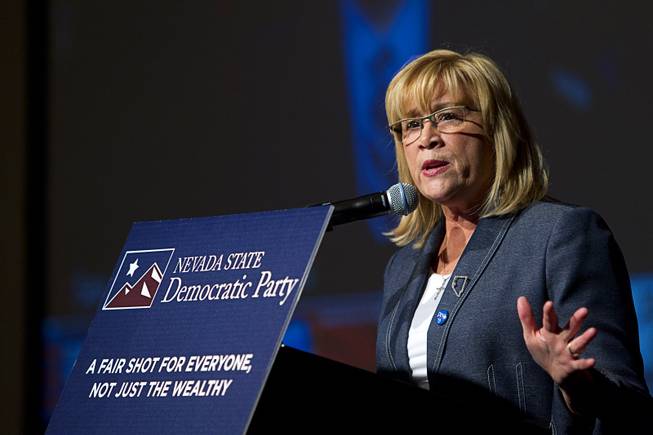
Nevada Democratic Party Chairwoman Roberta Lange speaks during an election night party for Democrats on Tuesday, Nov. 4, 2014, at MGM Grand.
Wednesday, Dec. 9, 2015 | 2 a.m.
The Supreme Court heard arguments Tuesday on a case that could reshape Nevada’s political geography by boosting the power of rural areas at the expense of Clark County — a prospect that concerns Democrats and civil rights leaders.
“It’s a flat-out direct attack on urban communities and a young population,” said Assemblyman Nelson Araujo, a Democrat who represents parts of Clark County near the North Las Vegas Airport. He was joined in opposition by Kevin Hooks, the president and CEO of the Las Vegas Urban League.
A decision on the case, Evenwel v. Abbott, could tip power in legislatures across the country toward rural districts that contain greater proportions of older white residents at the expense of urban districts with greater populations of younger minorities. It could also bolster Republicans and the expense of Democrats.
The court will decide whether drawing up legislative districts should be based on total population — as is currently done — or the number of eligible voters. People who are not eligible to vote include those younger than 18, immigrants, felons who have not had voting rights restored and prisoners. The case has been brought by conservative activists in Texas as a challenge to the state’s Senate district boundaries.
To view a data visualization of how the districts would change, click here.
Should the court revise the rules, “the shift that this would cause in who wins in elections and on policies in states like Nevada will be profound,” said Thad Kousser, a professor of political science at the University of California, San Diego, who studies state politics. “Immigrant populations would lose significant clout, and this could make the sort of anti-immigrant rhetoric that we are seeing in this presidential primary more politically palatable in legislative contests.”
In a 1964 decision, the Supreme Court held that districts for legislatures had to contain roughly the same amount of population. (The federal Constitution established similar rules for the House of Representatives, including a provision counting three-fifths of slaves for electoral purposes.) Prior to that decision, the Nevada state Senate’s members represented as many as 127,000 people or as few as 568.
Of the 2.8 million residents of Nevada, an estimated 930,000 are not eligible voters, including 600,000 who are younger than 18. Assemblyman Edgar Flores, a Democrat who represents a district near Nellis Air Force Base, would lose 60 percent of his constituents — about 40,000 people. By contrast, the Republican representative for parts of rural Lincoln and Nye counties would lose 26 percent of his constituents, or 16,000 people. Districts that lose population could be combined with others, a change that would disproportionately sap Democrats of seats that the party holds.
“The blatantly partisan goal of this lawsuit is clear: to help Republicans win elections by undercounting young people and minority communities, which tend to lean Democratic,” said Nevada Democratic Party Chairwoman Roberta Lange.
But Flores and Araujo also raised moral arguments against changing the rules.
“Even if it were just a 2 percent loss,” said Flores, “nobody should be walking around our state feeling like they did not have a voice.”
Added Araujo, “We have every right to our voice; our voice is our power.”

Join the Discussion:
Check this out for a full explanation of our conversion to the LiveFyre commenting system and instructions on how to sign up for an account.
Full comments policy